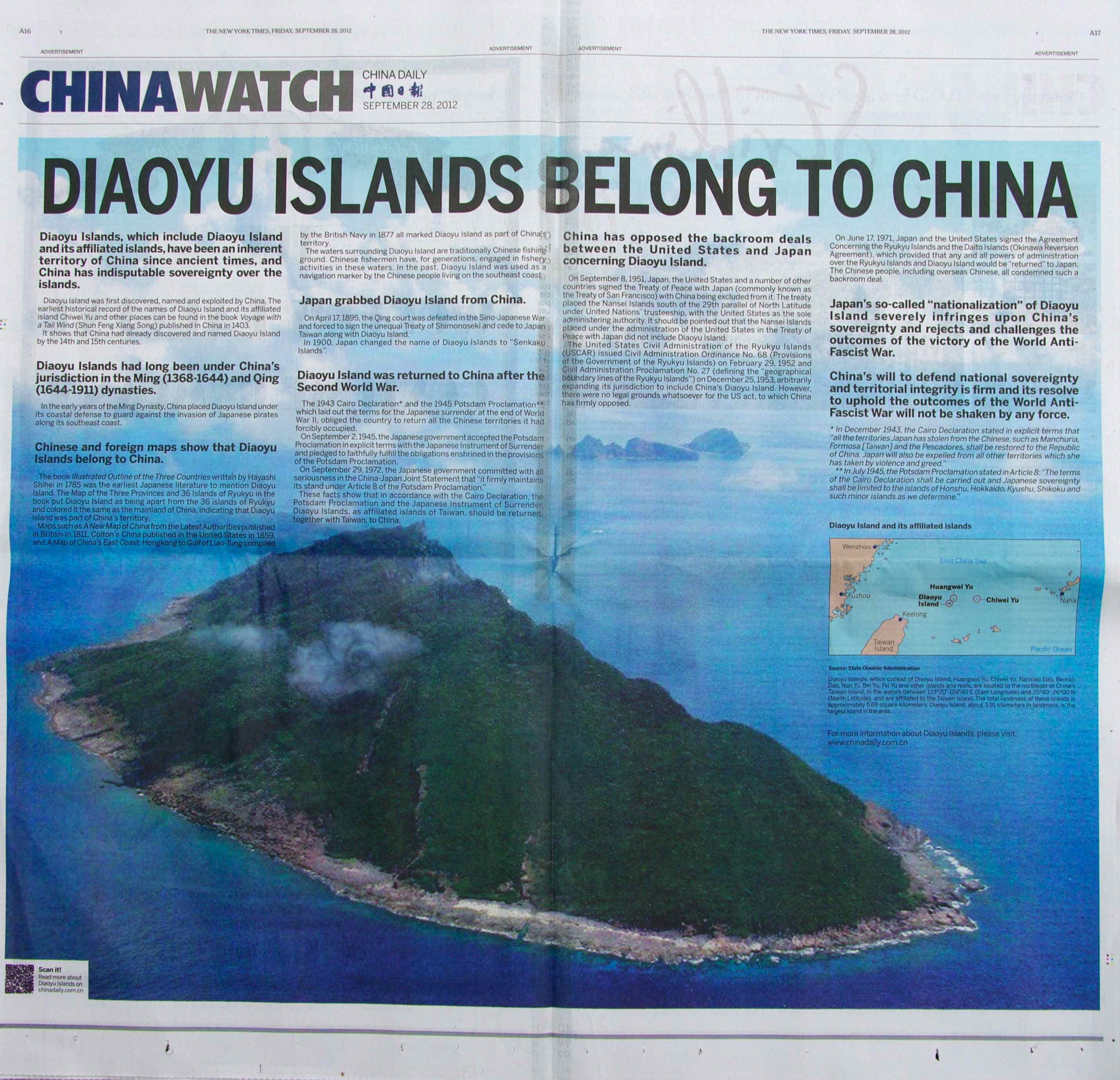MAP for reference and CLICK TO ENLARGE MAP to see small print
http://nuclearrisk.files.wordpress.com/2012/09/imgp3749s.jpg
A small insert map said it all. When the "tussle" -- as one Western
news agency put it -- between
China, Japan and Taiwan over ownership of islands in the East China
Sea spilled over into the prime display advertising real estate of the
New York Times and the Washington Post on September 28 when the Chinese
Communist Party (CCP) took out expensive double-page ads in both
papers, there was an important detail that almost
every news outlet in Taiwan, Japan and the U.S. missed.
On the small inset map accompanying both ads, the CCP cartographers
put China and Taiwan in the same color code, implying that Taiwan was
part of the People's Republic of China -- and worse, the CCP map
accepted as legitimate by the New York Times advertising department had
the words "Taiwan Island" printed over the sovereign nation of Taiwan.
And in small print below the map, an attentive reader could see the
following text which was credited as being sourced from the PRC's
State Oceanic Administration: "[The] Diaoyu Islands [釣魚台] ... are
located to the northeast of China's Taiwan Island ...and are
affiliated to the Taiwan Island."
Say that again? China administers an island called "Taiwan Island?
,And these Diaoyu islands are "affiliated" to the "Taiwan Island"? And
both the Times and the Post accepted this map text as a paid ad in
their pages? The directors of the advertising departments of both
papers should be ashamed of themselves for allowing a bully ad like
that to appear in their pages without any fact checking or editing.
In fact, the map and its caption was accepted by both the New York
Times and the Washington Post without as much as a peep from either of
the papers' reporters or editors. While the centerfold display ad in
theTimes -- ''among the most expensive real estate in all of
journalism," as one reporter put it was reported to have been
'''purchased by the China Daily newspaper." in fact, since the China
Daily is a state-run arm of the CCP, the funds for the media buys in
the U.S. came directly from the Chinese government.
Hiroshi Ito, a Japanese reporter for the Asahi Shimbun in Tokyo, put
it this way: "China Daily, a China-based English-language newspaper,
sponsored the ads, which both show a photo and a map of the Senkaku
Islands to bolster China's position on the territorial dispute. The
ads argue that the name Diaoyu Island, the largest of the group --
called Uotsurishima in Japanese -- is found in a book published in
1403, which shows that China had discovered and named it by the 14th
and 15th centuries."
Ito noted that after the ads appeared in the Times and the Post, the
Japanese Embassy in Washington and the Japanese Consulate General in
New York filed protests with both newspapers, citing factual errors.
But did the ROC file any protest with the papers, citing factual
errors in the insert map's caption that referred to the ROC as "Taiwan
Island"?
Ito further reported that both New York Times and Washington Post
editors denied that their newspapers supported the content of the CCP
advertisements, saying they would also take notice of the fact that the
Japanese government had filed a protest, But did anyone in the ROC
government think to file a protest over the name for Taiwan that China used in
the ads that appeared in the New York Times?
The insert map is so small t hardly matters. But in a world where
China matters so much,
Taiwan matters even more. Because Taiwan practices democracy and
trumpets freedom, and China does not.
Sure, China has every right to take out full page ads in Western
newspapers saying whatever it wants to say, but should those ads be
allowed to present falsehoods to readers?
Despite the small size of the insert map in the ad, the mislabeling of Taiwan
is a big thing. Because every time China gets away with a lie, it
paves the way for more CCP lies in the future.
Germany practiced this kind of deception in the 1930s and 1940s, and
look what happened. The former Soviet Union
practiced those kinds of deceptions on a daily basis, too. When will
the world wake up to China's devious deceptions as well,
even when they appear in very fine print in very small maps printed in
the New York Times?
==========
This guest blogger is a freelance writer in Taiwan.
Subscribe to:
Post Comments (Atom)

No comments:
Post a Comment